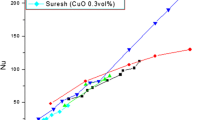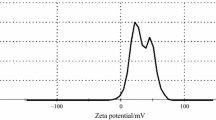Abstract
Nanofluids are obtained by dispersing homogeneously nanoparticles into a base fluid. Nanofluids often exhibit higher heat transfer rate in comparison with the base fluid. In the present study, forced convection heat transfer under laminar flow conditions was investigated experimentally for three types of non-Newtonian nanofluids in a circular tube with constant wall temperature. CMC solution was used as the base fluid and γ-Al2O3, TiO2 and CuO nanoparticles were homogeneously dispersed to create nanodispersions of different concentrations. Nanofluids as well as the base fluid show shear thinning (pseudoplastic) rheological behavior. Results show that the presence of nanoparticles increases the convective heat transfer of the nanodispersions in comparison with the base fluid. The convective heat transfer enhancement is more significant when both the Peclet number and the nanoparticle concentration are increased. The increase in convective heat transfer is higher than the increase caused by the augmentation of the effective thermal conductivity.








Similar content being viewed by others
Abbreviations
- A:
-
Heat transfer area (m2)
- CP :
-
Heat capacity (kJ/kg K)
- D:
-
Tube internal diameter (m)
- h:
-
Heat transfer coefficient (W/m2 K)
- hr :
-
Relative heat transfer coefficient (dimensionless)
- k:
-
Thermal conductivity (W/m K)
- K:
-
Consistency index (Pa sn)
- L:
-
Tube length (m)
- LMTD:
-
Log mean temperature difference (K)
- n:
-
Power law index (dimensionless)
- Nu:
-
Nusselt number (dimensionless)
- Nur :
-
Relative Nusselt number (dimensionless)
- Pe:
-
Peclet number (dimensionless)
- Pr:
-
Prandtl number (dimensionless)
- Re:
-
Reynolds number (dimensionless)
- T:
-
Temperature (K)
- u:
-
Fluid average velocity (m/s)
- ϕ:
-
Particle volume concentration (dimensionless)
- \( \dot{\gamma } \) :
-
Shear rate (1/s)
- ρ:
-
Density (kg/m3)
- τ:
-
Shear stress (Pa)
- b:
-
Bulk
- bf:
-
Base fluid
- nf:
-
Nanofluid
- p:
-
Particle
- w:
-
Wall
References
Maxwell JC (1881) A treatise on electricity and magnetism, 2nd edn. Clarendon Press, Oxford
Murshed SMS, Leong KC, Yang C (2008) Thermophysical and electrokinetic properties of nanofluids––a critical review. Appl Therm Eng 28:2109–2125
Yu W, France DM, Routbort JL, Choi SUS (2008) Review and comparison of nanofluid thermal conductivity and heat transfer enhancements. Heat Transf Eng 29(5):432–460
Wen D, Ding Y (2004) Experimental investigation into convective heat transfer of nanofluids at the entrance region under laminar flow conditions. Int J Heat Mass Transf 47:5181–5188
Yang Y, Zhang ZG, Grulke EA, Anderson WB, Wu G (2005) Heat transfer properties of nanoparticle-in-fluid dispersions (nanofluids) in laminar flow. Int J Heat Mass Transf 48:1107–1116
Ding Y, Alias H, Wen D, Williams RA (2006) Heat transfer of aqueous suspensions of carbon nanotubes (CNT nanofluids). Int J Heat Mass Transf 49:240–250
Heris SZ, Etemad SGh, Esfahany Mn (2006) Experimental investigation of oxide nanofluids laminar flow convective heat transfer. Int Comm Heat Mass Transf 33:529–535
Nguyen CT, Roy G, Gauthier C, Galanis N (2007) Heat transfer enhancement using Al2O3-water nanofluid for an electronic liquid cooling system. Appl Therm Eng 27:1501–1506
He Y, Jin Y, Chen H, Ding Y, Cang D, Lu H (2007) Heat transfer and flow behaviour of aqueous suspensions of TiO2 nanoparticles (nanofluids) flowing upward through a vertical pipe. Int J Heat Mass Transf 50:2272–2281
Chen H, Yang W, He Y, Ding Y, Zhang L, Tan C, Lapkin AA, Bavykin DV (2008) Heat transfer and flow behaviour of aqueous suspensions of titanate nanotubes (nanofluids). Powder Technol 183:63–72
Bi S-s, Shi L, Zhang L-l (2008) Application of nanoparticles in domestic refrigerators. Appl Therm Eng 28:1834–1843
Duangthongsuk W, Wongwises S (2009) Heat transfer enhancement and pressure drop characteristics of TiO2–water nanofluid in a double-tube counter flow heat exchanger. Int J Heat Mass Transf 52:2059–2067
Rea U, McKrell T, Hu Lw, Buongiorno J (2009) Laminar convective heat transfer and viscous pressure loss of alumina–water and zirconia–water nanofluids. Int J Heat Mass Transf 52:2042–2048
Hwang KS, Jang SP, Choi SUS (2009) Flow and convective heat transfer characteristics of water-based Al2O3 nanofluids in fully developed laminar flow regime. Int J Heat Mass Transf 52:193–199
Kulkarni DP, Vajjha RS, Das DK, Oliva D (2008) Application of aluminum oxide nanofluids in diesel electric generator as jacket water coolant. Appl Therm Eng 28:1774–1781
Ding Y, Wen D (2005) Particle migration in a flow of nanoparticle suspensions. Powder Technol 149:84–92
Wen D, Ding Y (2005) Effect of particle migration on heat transfer in suspensions of nanoparticles flowing through minichannels. Microfluid Nanofluidics 1:183–189
Heyhat MM, Kowsary F (2010) Effect of particle migration on flow and convective heat transfer of nanofluids flowing through a circular pipe. J Heat Transfer 132:062401
Incropera FP, DeWitt DP (1996) Fundamentals of heat and mass transfer, 4th edn. Wiley, New York
Hojjat M, Etemad SGh, Bagheri R, Thibault J (2009) The thermal conductivity of non-Newtonian nanofluids. 8th World Congress of Chemical Engineering, Montreal, Canada
Hojjat M, Etemad SGh, Bagheri R, Thibault J (2009) Rheological behavior of non-Newtonian nanofluids. The 6th Int Chemical Engineering Congress & Exhibition, Kish Island, Iran
Pak BC, Cho YI (1998) Hydrodynamic and heat transfer study of dispersed fluids with submicron metallic oxide particles. Exp Heat Transf 11:151–170
Xuan Y, Roetzel W (2000) Conceptions for heat transfer correlation of nanofluids. Int J Heat Mass Transf 43:3701–3707
Acknowledgments
Financial assistance of the Petrochemical Research and Technology Company in I. R. Iran is gratefully acknowledged.
Author information
Authors and Affiliations
Corresponding author
Rights and permissions
About this article
Cite this article
Hojjat, M., Etemad, S.G., Bagheri, R. et al. Laminar convective heat transfer of non-Newtonian nanofluids with constant wall temperature. Heat Mass Transfer 47, 203–209 (2011). https://doi.org/10.1007/s00231-010-0710-7
Received:
Accepted:
Published:
Issue Date:
DOI: https://doi.org/10.1007/s00231-010-0710-7




